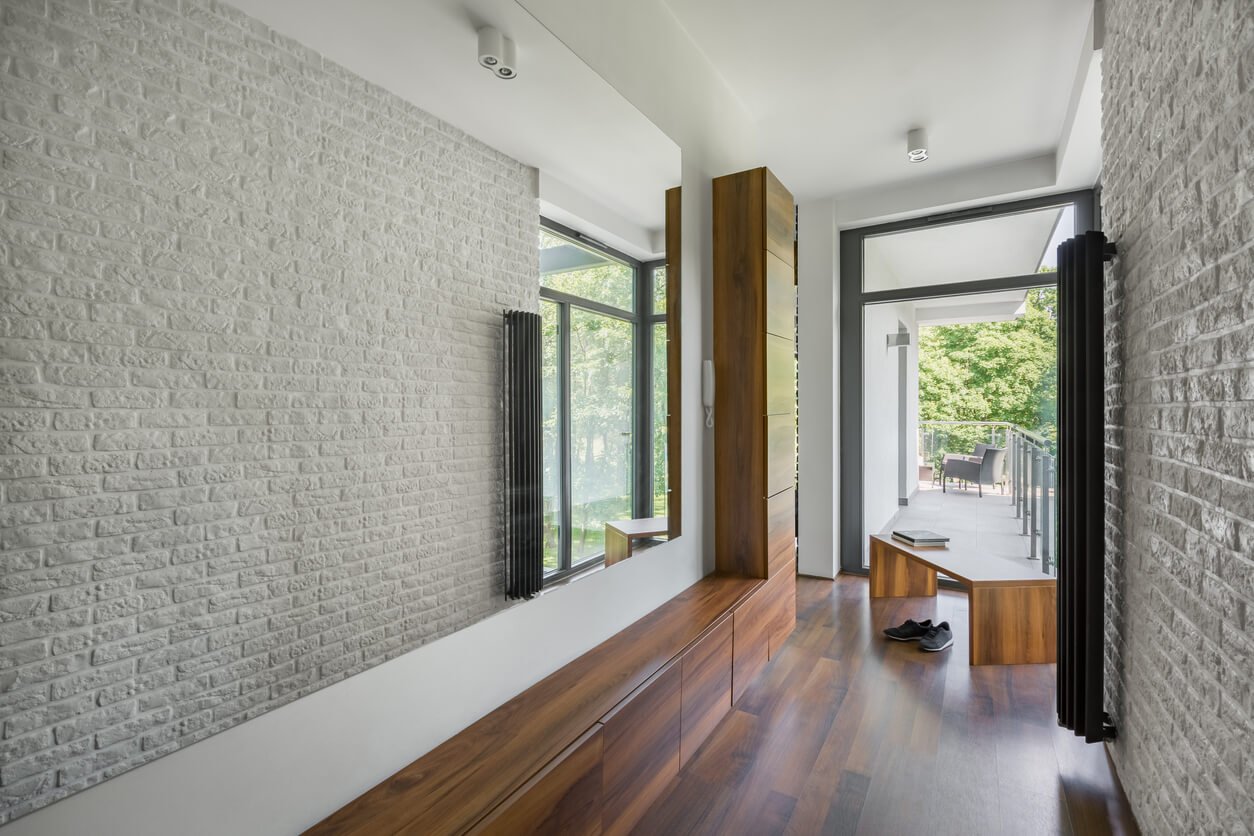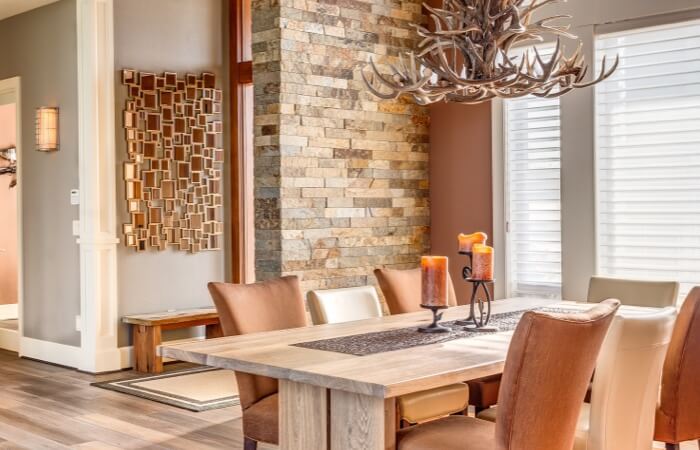There’s something wholly unique about the use of stone in construction. Having been used for millennia as a building resource, today stone is still mined in natural quarries and then cut and sliced for use in constructing flooring, walls, exteriors and landscaping.
As each stone pulled from the earth is one-of-a-kind in size, shape and mineral composition, the achieved final look is entirely original to that particular construction. No two structures will look quite the same. It’s this timeless look, in addition to stone’s strength and durability, that has kept it as a desirable building resource despite the introduction of other materials like wood, brick, stucco and vinyl.
Piling stones and mortar creates a solid stone foundation, but there’s also the alternative of using stone veneer as a siding. Stone veneer can be natural stone cut thin, or it could be a man-made material engineered to look like real stone, also referred to as architectural stone, cultured stone or manufactured stone. Manufactured stone veneer is usually created by combining cement or similar mixtures with iron oxides into a mold, then often painted or colored to stone’s natural variation of looks.
If you’re looking to build something with the unique look of stone, it’s worth considering whether solid stone or stone veneer is more appropriate for your project and budget. Or perhaps even other alternatives.
Solid Stone
The biggest factor with stone comes down to weight. Natural stone is extremely heavy, the heaviest of all the most common building materials. This strength and density are why it’s valued for its durability and longevity, but also why it can pose a challenge.
Natural stone is difficult to cut and shape, leaving you a choice between trying to make some awkward fits for pieces, or absorbing the cost of cutting and shaping pieces. Construction requires the work of a skilled stonemason, to ensure that joints are tight, lines are straight and corners are built correctly.
Although stone is durable, as a natural material some types are vulnerable to harsh chemical cleaners. Avoid cleaning your stone with products containing acids, ammonia, bleach or other harsh cleaning products as you can risk stripping the color or even damaging the surface of your stone. Clean with a soft-bristled brush or sponge and rinse with water until no soapy residue remains.
Cost
Stone is one of the most expensive materials to work with, as materials can range from $35 to $50 per square foot. Part of the expense comes because natural stone must be quarried from specific locations, so availability of certain types of stone will vary by region. You may not have access to the stone you want, or else need to pay extra for transportation.
Masonry is considered very labor-intensive work, so expect to pay between $20 and $30 per square foot for installation. Alternatives to stone, like faux wall panels from Texture Plus, require less skilled labor to install and so can save on both time and money.
Installation
Stone either needs to be laid directly onto concrete, stone or a block by a skilled mason. It is possible to build free-standing stone walls without cement or mortar, but that requires very precise construction and that the structure be tapered inward. Cement and mortar allow for the construction of more stable, free-standing stone walls while also providing more protection against moisture and the elements.
The laying of stones requires careful planning, as the asymmetrical shapes require specific placements to ensure solid construction and an appealing visual presentation.
Insulation
Although it is incredibly dense, stone is considered a thermal mass material rather than a true insulator. While stone can absorb and store heat, it cannot slow down the transfer of energy like insulation or insulated materials.
Especially thick stone walls can act as insulation, but during stretches of hot weather heat will continue to build within the structure, effectively turning it into an oven. In hotter climates you’ll need to place actual insulation to block heat from entering the stone. You can also reduce heat transfer by berming or earth-sheltering your structure, though this may depend on the landscape and height of the water table.
Benefits of Solid Stone:
- Durability: Natural stone is one of the heaviest and densest materials used in construction. It’s fireproof and resistant to environmental damage. Its look is also resistant to fading over long periods of time.
- Resilience: When constructed without wood framing, stone is impervious to insect damage or natural decay.
- Low-Maintenance: Stone’s longevity makes it extremely low-maintenance. Requiring repair after only extreme circumstances or many decades of wear.
Drawbacks of Solid Stone:
- Cost: Stone is more expensive as a material, challenging to work with and requires installation from a skilled mason. The installation process is also time intensive, making it one of the more expensive construction projects you can take on.
- Insulation: Stone is not a natural insulator, so you’ll need to either install secondary insulation or take a hit in utilities bills.
Stone Veneer
Stone veneer itself does not provide structural support, and so can only be used as a siding for a solid structure, such as wood or concrete frames. Artificially manufactured stone can be used as veneer and is lighter and more customizable than thin-cut stone.
Although stone veneer still requires the skills of mason, its easier installation process has made stone veneer the construction choice for most who are looking for that timeless stone look.
Like solid stone, stone veneer can be damaged by harsh chemical cleaners. Clean your surfaces with a mild dishwashing detergent, or a mixture of warm water and vinegar, and apply with soft-bristle brushes or cloth.
Cost
Natural stone veneer, though cut thinner than solid stone, will still cost anywhere from $15 to $30 per square foot. Manufactured stone is available for a fraction of that cost, from $8 to $12.50 per square feet. Veneer does still require masonry, though there’s no need to rely on setting a solid foundation, which helps to cut down the complication and construction time.
Installation
Stone veneer should be attached to a heavy structure using metal and wooden frames, over concrete masonry block or brick, or over poured concrete. This style of construction uses multiple layers to provide support and protect against the elements:
- Solid interior construction for stable foundation
- Asphalt felt or grade D building paper for a moisture barrier
- Galvanized metal lath (a lightweight steel frame) to support the mortar
- Scratch mortar coat to support the stone
- Stone veneer layer
It should be noted that even thin stone veneer is too heavy to be attached to lightweight materials, such as drywall. Just as with brick masonry, stone veneer will need proper drainage to remove any incidental water that may infiltrate the supporting wall.
Just as with standing stone, masonry is required and the areas between the stone veneer can be filled with grout or mortar to strengthen the structure and keep out moisture. Because it is more lightweight than standing stone structures, stone veneer can be used for indoor as well as outdoor walls.
Insulation
Thinner stone veneer is less of a thermal mass and so it provides no useful insulation. The backing wall will need to be constructed to provide any needed insulation. In the cases where natural stone is used as a veneer covering to a structure, weep holes will need to be added to allow moisture to escape.
Benefits of Natural Stone Veneer
- Timeless look: Stone veneer shares the same natural look as solid stone wall construction. The material will last as long as solid stone and the color will not fade.
- Easier installation than stone: Stone veneer doesn’t need to be constructed to support itself, and so is easier to construct than standing stone. However, it’s still labor-intensive work and shouldn’t be considered simple.
- Can be insulated: Though it provides no insulation itself, when placed on a properly insulated wall, a stone veneer wall can provide useful insulation.
- Can be used indoors: Stone veneer is light enough to be placed on indoor walls, if properly constructed.
Drawbacks of Stone Veneer:
- Still costly: Like solid stone, natural stone veneer requires masonry and is relatively expensive as a material.
Benefits of Manufactured Stone Veneer:
- Same benefits as natural stone veneer: Manufactured stone closely resembles the look of natural stone and when used as a veneer has an easier installation and can be placed on an insulated wall indoors or outdoors.
- Customizable: Manufactured stone veneer can be shaped in molds, providing consistent shapes for easier construction. It is also lighter than full standing stone, making it easier to transport and work with.
- Less expensive: Manufactured stone veneer can be half of the cost of natural stone material.
Drawbacks of Manufactured Stone Veneer:
- Not as long-lasting: Manufactured stone must be artificially colored, and that color fades with time and the elements.
- Not as resistant: The composite mix of manufactured stone is vulnerable to having its appearance damaged by harsh chemicals like chlorine or industrial cleaners. Use even greater levels of care when cleaning, avoid the use of pressure washers.
Solid Stone vs. Stone Veneer and Manufactured Stone Veneer
| Material Cost | Installation | Insulation | |
| Real Stone | $35 to $50 per sq ft.
|
High cost and requires masonry. Outdoor only. | Works as a thermal mass, but no insulation |
| Stone Veneer | $35 to $50 per sq ft.
|
High cost and requires masonry. Indoor and outdoor. | Can provide insulation with proper backing |
| Manufactured Stone Veneer | $8 to $12.50 per sq ft.
|
Low cost and requires masonry. Indoor and outdoor. | Can provide insulation with proper backing |
| Faux Stone Wall Panels | $8 to $12.50 per sq ft.
|
Low cost and requires no masonry to install. Indoor and outdoor. | Can easily cover insulated walls |
Get the High-End Stone Look Without the High Costs
There’s another option for achieving the look and feel of natural stone. Faux stone wall panels are a quick and simple way to add the eternal beauty of stone to your home.
Faux stone wall panels offer many benefits, including:
- Lightweight and easy to install, no masonry required
- Ideal for indoor or outdoor applications
- Durable and long-lasting
- Available in realistic, custom styles
Texture Plus faux stone wall panels are incredibly realistic and designed to withstand the elements, meaning they can be added to the interior or exterior of your home.
The best part? Installing faux wall panels can be completed as a DIY project! There’s no need to hire a mason — all you need are your faux wall panels, adhesive and screws.
Our faux wall panels are available in over 850 designs. Take a look at your faux stone wall panels options or contact one of our specialists for assistance.

